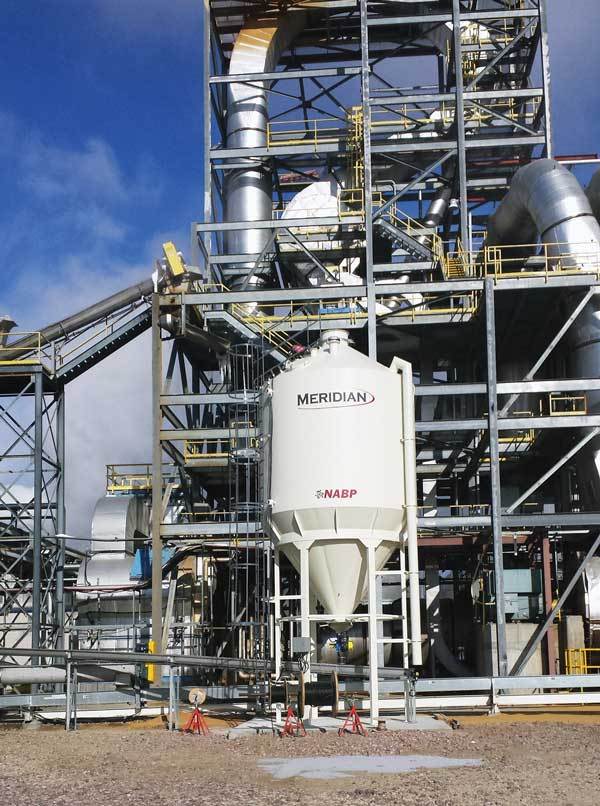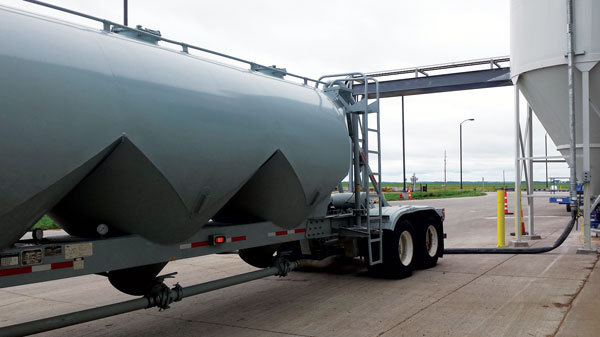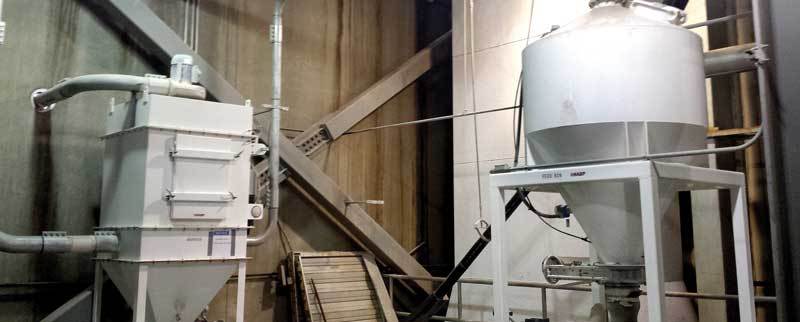Adding Flowability





PHOTO: NABP
February 10, 2017
BY Debbie Sniderman
A new mineral additive technology offering energy and yield benefits to DDGS processing has been developed by Nucleus Ag & Bio Products, Lakeville, Minnesota. The anticaking agent absorbs moisture allowing ethanol plants to lower the relative moisture of their outgoing DDGS, with multiple benefits. Todd Seaton, NABP U.S. sales manager, says, “Many plants over-dry the grains to load or unload them from rail cars and trucks. If they’re not dry enough, they are difficult to unload. Because plants want flowability, they dry their grains to 9.5 or 10 percent moisture, losing yield in the process. Over-drying the grains uses more energy, and drying longer than needed wastes energy.” The additive also improves the nutritional value of the DDGS, Seaton says. “Any one of these benefits alone could add profitability to an ethanol plant.”
Vertex DDGS Enhancer is composed of finely ground food-grade minerals. It works by micro-encapsulating DDGS fibers to keep them from sticking together. The added minerals adhere to the grains like a coating and absorb excess moisture, allowing the DDGS to flow. The treatment adheres best to the grains when blended with DDGS after they are dried and cooled. Improved safety is an additional benefit, as reduced clumping aids front-end loading operations. A patent-pending delivery system applies the precise amount of mineral blend using rotary valves, airlocks and screw conveyors. NABP offers indoor and outdoor versions of the Vertex System to accommodate different plant configurations.
Vertex changes the nutritional profile of DDGS increasing iron, calcium and other minerals and acts as a natural intestinal detoxifying agent. The natural additive in Vertex also enhances the color of DDGS, making it lighter and scoring higher on the Hunter L scale. Seaton says the feed industry recognizes there is value to the color of feed and prefers this color enhancement. The Hunter L score of DDGS at the Tharaldson Ethanol customer site increased five or six points with the addition of Vertex, he says, opening new markets. Seaton adds Vertex has generally recognized as safe status and is compliant with the new Food Safety and Modernization Act regulations.
Seaton worked in the ethanol industry for more than 35 years. After retiring, he and his wife Susan Seaton, the product’s inventor, knew of some problems and where to add value in the ethanol industry. They wanted to help, and together created the Vertex product. “NABP exists to bring added value to our friends in the ethanol industry,” he says. “During trials, one plant was able to use more syrup in their DDGS, which helped increase DDGS yield.”
When NABP started in March 2015, it delivered the product in Supersacks, which took a long time to load and resulted in expensive freight charges. Unloading into an auger blending machine was labor intensive. NABP cut costs by moving to 25-ton pneumatic bulk loads delivered to plants for storage in silos. “At first, the costs of sourcing, blending and drying the minerals and getting them to the plant and applying them were high. It took a while to perfect,” Seaton says. “But now, costs are competitive with what the end user pays for DDGS. Ethanol plants can recover up to 100 percent of their costs and increase their DDGS yield, so it makes sense.”
First Adopters
Jeff Wilson, vice president of chemical sales at NABP describes Vertex as an early-stage product. Plant trials have been completed at 100 MMgy and 50 MMgy corn-ethanol plants, with one commercial system running and another in the startup phase. “Plymouth Energy in western Iowa is excited about the technology and a system is currently being installed there. Four trials were also done at GPRE in Fergus Falls, Minnesota, who also loved the product,” Seaton says.
Tharaldson Ethanol, Casselton, North Dakota, was NABP’s first customer and pilot facility. Tharaldson produces 168 million gallons of ethanol and about 450,000 tons of distillers grains each year, and operates its own fleet of DDGS rail cars. Vertex additive is applied after the dryers while the coproduct is conveyed to the storage building. The additive system includes an outdoor storage tank, a screw delivery system, a baghouse and feeder bin.
According to Bill Paulsen, general manager of ICM Energy Management Solutions, which manages Tharaldson Ethanol, the Vertex technology adds value through energy savings and faster turns on rail equipment, accompanied by less damage to rail cars. “After adding this product, we were able to increase paybacks to the facility in multiple ways.”
Paulsen says the most important factors for deciding to use it were issues with rail shipments. Before using Vertex, the unloading time for customers in the South took longer, and they had to vibrate or beat on the cars to get the distillers out. The trains took longer to get back to the ethanol facility, and there were time constraints for getting cars loaded. “Our biggest problems were when the DDGS were sitting in a hot rail line for three days in the humidity. They would settle and get hard, and it was painful for our customers to unload,” Paulsen says. “In the 22 months since we started using Vertex, we haven’t seen any more issues like these. There are no problems flowing, and the flowability lasts. We visited one customer in Texas and they have nothing but compliments about the product and how well it now comes out of cars. The turns of getting rail cars back from that customer have been phenomenal. That’s what allowed us to make the decision quickly.”
Reductions in damage to cars has been significant, says Ryan Carter, general manager of Tharaldson Ethanol. “We see a large value in not getting the cars beat up and having to repair them, since each car is repaired at different times, and no repair is less than $10,000.” He estimates they have seen a two-day faster turn on facility rail cars, allowing them to downsize their fleet.
“We’ve become a preferred provider to all of our customers because of the flowability and consistent product. We took a good product and gave it an additional boost that competitors today don’t have,” Carter says.
On the energy side, using Vertex allowed Tharaldson to run year-round at increased moisture, which meant not running the dryers as hard. “This cut the energy usage in the facility, creating a better bottom line. It reduced the natural gas used per gallon of ethanol produced,” Carter says. “We used to run our dryers at 100 percent. Now, with Vertex, they run at 90 percent, which is a decrease of about 6 to 8 decatherms per hour, which saves 5 to 10 percent on dryer gas,” he says. “We used to have to run 9 percent moisture in the feed to make it flow. Today, running 12 percent moisture, the drying time is still the same, but it helps dryer efficiency.”
Carter estimates the return on investment at Tharaldson is less than a year, noting that ROI will be different for every plant. “Going to the max of 12 percent moisture means more water is sold out the back end. It’s heavier feed, so there’s a quicker payback. There are also lower emissions from using less natural gas, which reduces the [carbon intensity] score and helped us move forward going for our low carbon fuel standard permit and EP3 petition for efficient producers. Any project like this helps in the long run,” he says.
Carter says DDGs are sent out for nutritional testing every day, and the values of calcium and iron increased. “This is one less thing the end user has to do, purchase calcium or iron to supplement into their feed. It’s a cost the consumer is getting back that we’re taking care of,” he explains.
“We have not had one complaint about this product, and have had a lot of compliments on quality and the appearance of the feed. We are hoping to add Vertex at more facilities,” Paulsen adds.
Author: Debbie Sniderman
CEO, VI Ventures LLC
info@vivllc.com
Advertisement
Advertisement
Related Stories
U.S. fuel ethanol production was down 4% the week ending April 4, according to data released by the U.S. Energy Information Administration on April 9. Stocks of fuel ethanol expanded by 2% and exports were up 180%.
Aemetis Inc. on April 8 announced that its production of renewable natural gas (RNG) increased 55% in March compared to February. Aemetis Biogas also completed a sale of LCFS and D3 RINs at the end of Q1.
North Dakota’s largest ethanol plant finds success through scale, refinement and change.
The U.S. exported 138.75 million gallons of ethanol and 849,645 metric tons of distillers grains in February, according to data released by the USDA on April 3. Exports of both products were down when compared to February 2024.
U.S. fuel ethanol production was up 1% the week ending March 28, according to data released by the U.S. Energy Information Administration on April 2. Stocks of fuel ethanol were down 3% and exports were down 62%.
Upcoming Events










